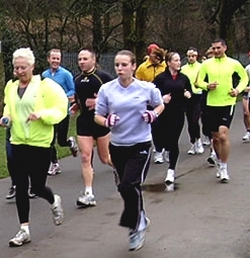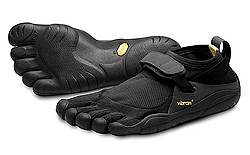Q&A: How to Find Your Ideal Running Stride Length, Rate, Form
Recently, the focus of many recreational runners has shifted from faster times and longer distances, to finding and maintaining their ideal stride length both for enjoyment and avoiding injuries. There is increase emphasis on circuit training methods, and shorter more intense work-outs rather than the slow daily slog. Both committed athletes and recreational runners are looking for training methods that will meet their goals while reducig the risk of injuries (nothing is slower than that). The key is for each runner to find their ideal stride and their Magic Pace.
Most runners have a poor running stride in one of two ways:
- The stride is inefficient and wastes energy
- It creates greater risk of injury.
Why Do Runners Adopt Bad Running Strides?
In some ways the best stride that is ideal for both purposes is the one we spent our childhood running using when playing barefoot. But when people start running as adults, they tend to take longer, slower steps instead of the short, quick steps they did naturally. Because of this they tend to land on the ground with the foot positioned too far out in front of the body. This means that after each stride a heel-first stressful landing is required that generates much higher loads on the hip, ankle and knee joints than the loads experienced by children running around barefoot.
What is the Role of Modern Running Shoes?
Modern running shoes can be a major cause of problems with stride length. Oddly because they are so well designed and padded that they partly interfere with the feedback you get through the bottom of the foot when running with no shoes. It is very hard to over-stride barefoot and land with a pronounced thud on your heels when running bare foot or thin-soled shoes, because you feel it and it hurts. Research studies have shown that the modern running shoe has in increased stride length by 20-30% from 150 strides per minute to between 170 and 190 strides. Running Barefoot has been shown to be less energy efficient than wearing minimal shoes. It is all about making the right decision considering all the various issues.
Is it Worth Trying a Shorter Stride?
One option, then, is to try minimalist shoes and use a simply method to reduce your stride length. Counting the number of steps you take over a measure distance and then try consciously increasing the number of step, using a shorter stride, by 5 to 10 %. It is a good ideal to use an electronic metronome to make these changes and to get used to a different pace. Taking shorter, faster strides, puts less strain on the knee and hip joints.
There was negative aspects for this tactic that you should consider. Shorter strides led to put extra strain and force on the ankle. Also switching to barefoot or minimalist shoes at the same time can cause problems in the calf muscles, ball of the foot and to the Achilles tendon. It is best to make changes slowly one at a time.
Does the Ideal Stride Improve Metabolic Efficiency?

Research has shown that everyone has an ideal stride length that produces the maximum metabolic efficiency (see the graph). Lets call this the 'Maximal Efficiency Gait' (MEG). The efficiency can be measured directly my monitoring oxygen consumption a a gym ( VO2 max ) or indirectly by monitoring heart rate.
Most runners tend to overstride by 20-30%, that is their stride length is longer than their MEG. You can quickly determine if you tend to overstride becuae your foot tends lands in front of your knee. This overstriding can generate jarring on the joints and is less efficient. Overstriding restricts the ability of your knees to deal with some of the impact. Many runners find that by shortened their stride a little they run more efficiently and with less jarring using a more gentle gait.
However, as the graph shows you can understride as well. You then run inefficiently by not covering enough ground with each stride. Theres a definite point of diminishing returns with stride length, and the MEG is a bell curve.
To work out your own MEG follow these simply steps:
- Get a simple electronic metronome or an app for your smart phone that does the same thing
- Start with the standard 180 steps per minute pace as a guide.
- Try different rates over a set distance, measure you times and see which stride pattern seems to work for you.
- Try minimal shoes and see what stride causes the least amount of jarring for a given pace.
- Recognise that peak efficiency and MEG may need to change in response to various conditions such as shoe type, speed, total distance, track conditions and terrain, your current level of fitness and weight and even weather conditions.
- The Sustained Energy Efficiency or Recovery Zone is achieved at about 60% to 70% of your maximum heart rate. You can determine this using a stress test and a heart rate monitor. To so this you need to run 800 m (or yards) at your maximum rate. For the first 400 m (or yards) meters run at about 90 to 95% of your peak effort. For the last 400 m (or yards) really go for it and aim to work at 100% effort.
Your heart at the end of the stress test is your maximum heart rate. Training within the 60-70% of maximum heart rate zone develops endurance and builds your aerobic capacity. Try running with various strides while monitoring your heart rate and determine the fastest and most comfortable stride for the nominated heart rate. Try repeated session using shorter and longer strides. Eventually you should determine a stride length that feels the best for you, enabling you to sustain the pace you want and yet feel comfortable, with virtually no jarring.
How do You Use the Cruise Control System for Runners?
Every runner has a unique stride length and step frequency that feels good, without undue strain for any given speed. The best way to do this is using a metronome and one of the many running apps that are available to monitor the distance you have travelled and your speed. You should aim to maintain you ideal cruise speed while matching your pace with the metronome. Some advanced runners apps do both of these things for you.
What is Chi Running?
This running style combines the principles of an ideal running form with the discipline of the famous martial art tai chi. The emphasis using this method is to combine: good posture, use of core strength to assist the legs, relaxation techniques for the leg muscles and the concept of remaining mindful during with every step.
There are many books available on both Chi Walking and Chi Running. The methods focuses on learning to develop a strong core allowing the legs to be more relaxed. This helps to reduce the risk of injuries. A Chi runner aims to run with a straight back, but leaning slightly forwards so that gravity helps pull the body forward.
The focus with the legs is more on supporting the body between strides, with less focus on propulsion. The body core is used to provide more of the propulsion. A Chi runner is taught to keep the knees slightly bent at all times. The foot strikes the ground with the middle of the foot rather than the heel, directly under the body and not in front of the knee. Read the books for more details on this method.
Conclusion:
Stride length and the perfect pace are the most important aspects of good form that improves efficiency and minimizes the risk of injury.
